The African sideneck turtle has a long neck with a dark brown shell and olive/brown skin. The turtle features black markings on its head alongside big round eyes and an upturned mouth. The African sideneck turtle is native to the lakes, rivers, and ponds of Angola, Senegal, Liberia, Guinea in West Africa, and the Congo in central Africa.
African sideneck turtles have moderate care levels. The turtles are hardy and have a dynamic personality making them ideal pets for experienced turtle owners and beginner hobbyists. African sideneck turtles do well in captivity, provided their keepers give them the right care.
African Sideneck Turtle Overview

| Common Names (s) | African side-necked turtle, African helmeted turtle |
| Scientific Name | Pelomedusa subrufa |
| Natural Habitat | Freshwater lakes, ponds, rivers, and streams in Angola, Liberia, Guinea, Senegal, Sierra Leone, and the Congo |
| Adult Size | 7-12 inches |
| Average Lifespan | 20 years |
| Diet | Omnivorous |
| Housing | Aquarium tanks |
| Experience level | Beginner |
Origin
The African sideneck turtle (Pelomedusa subrufa) originates from the rivers, lakes, and ponds in western Africa. The turtle is native to Angola, Senegal, Liberia, Guinea in West Africa, and the Congo in Central Africa. The African sideneck turtle is a semi-aquatic animal that inhabits the freshwater waters of its native homes.
The turtle prefers standing water bodies with muddy bottoms and surrounding vegetation. The African sideneck turtle’s habitat is prone to seasonal flooding but will also inhabit swamps, lakes, and ponds.
African sideneck turtles are common in the wild and available in Madagascar, an island nation in the Indian Ocean, and Seychelles, a chain of islands in the Indian Ocean. Countries such as Yemen record small populations of African sideneck turtles.
Appearance and Behavior
The African sideneck turtle has a long neck and a dark brown shell with olive to dark/brown skin. The turtle features black markings on its head above the eyes and a mouth that looks like the turtle is smiling. The African sideneck turtle’s plastron (underbelly) appears grayish brown and features two barbels that protrude from the turtle’s lower jaw.
The African sideneck turtle has webbed feet with sharp nails that allow it to swim underwater. The sharp claws are ideal for digging, a skill necessary when seeking food in the mud.
Male African sideneck turtles sport longer and thicker tails with a vent positioned close to the end. The females have short, slim tails, but they have a longer shell than males. Male African sideneck turtles have longer front leg claws than females.
Size and Lifespan
The average size of the African sideneck turtle is 7–12 inches (17.78–30.48 cm) for females and 7–10 inches (17.78–25.4 cm) for males. The difference in size comes from the longer shell bodies of the females compared to the males.
The average lifespan of the African sideneck turtle is 20 years. The turtle can survive up to 30 years in the wild but can live up to fifty years in captivity.
Temperament
African sideneck turtles are peaceful, but they can become aggressive. The turtles are curious and active, but they will stick out their tongues or use their claws to escape when nervous.
African sideneck turtles can peacefully coexist amongst other turtles of the same species. Small fish such as dwarf cichlids are part of the turtles’ diet, so ensure they aren’t kept together.
The turtles are social but still show aggressive signs when handled by humans, so African sideneck turtles are not suitable for handling by inexperienced turtle owners. This species stresses out easily when held and can become aggressive, which often leads to bites or scratches. Although shy at first when handled by people, these turtles will become curious and easier to handle over time.
Housing African Sideneck Turtles
The wild African sideneck turtle spends time in water and dry land. However, the turtle is adaptable to different environments. The turtle thrives in freshwater rivers, ponds, swamps, and lakes. Stagnant water provides a suitable habitat for the African sideneck turtle.
Housing an African sideneck turtle in captivity requires carers to mimic the turtle’s natural habitat. Provide a tank with a large area to swim and plastic plants for hiding spots. Fit the tank with driftwood, rocks, and aquatic plants to allow the turtle to feel at home.
Enclosure size
The ideal habitat for an African sideneck turtle is a 75-gallon aquarium or larger. The tank should be three-quarters water to allow sufficient swimming space for the turtle. Always check the water level to ensure it does not fall lower than half of the tank. Adjustable water depth is preferable because it makes cleaning easier and provides the turtle with different places to swim and bask.
A rectangular tank is ideal because the tank provides more room for the turtle to swim around. A long, narrow tank will limit the amount of swimming space available.
Lighting
African sideneck turtles are active during the day. Installing LED fixtures with day and night settings help keep the turtles active. The best-LED lighting for this purpose is T5 HO 6500 lamp as this light is strong enough to imitate natural daylight.
Temperature and Humidity
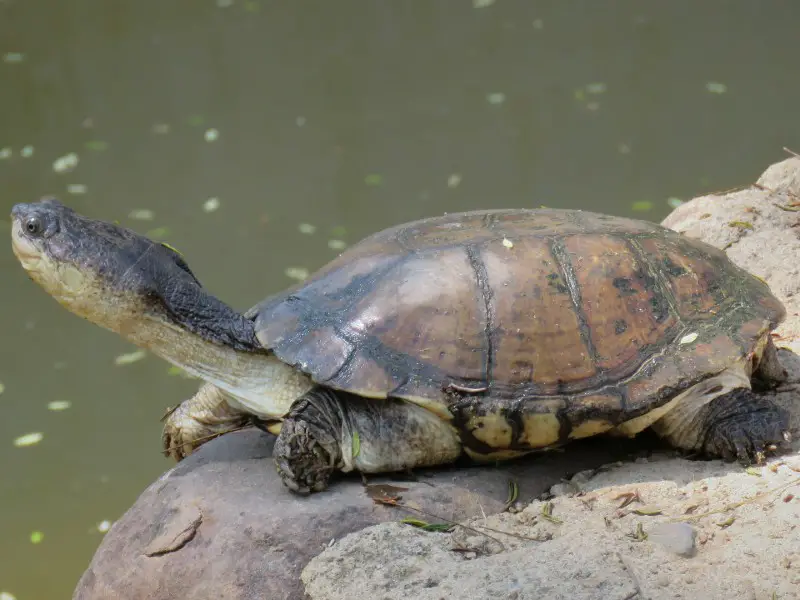
The ideal temperature for African sideneck turtles is between 70 and 75 degrees Fahrenheit, with the basking site reaching 95 to 100 degrees. African sideneck turtles are cold-blooded and need external heat to make their bodies work.
Place the basking site under an incandescent bulb or a 100-watt infrared bulb to keep the African sideneck turtle warm. The light should be bright enough to provide the turtle with basking capabilities.
Installing a heating pad or a heat lamp with a thermostat is an excellent idea. African sideneck turtles require temperatures warmer than the ambient air. Installing a hygrometer will help monitor the humidity levels, which should never exceed 50 percent.
The African sideneck turtle will start skin shedding when the water temperature rises beyond 75–85 degrees Fahrenheit. Skin shedding is a normal occurrence in healthy turtles. The process could also signify that the turtle is stressed, or fighting parasitic or bacterial infections, or poor nutrition, water quality, or environmental changes.
Substrate and Decoration
Sand and gravel make the best substrate for the African sideneck turtle. Gravel and sand provide a natural habitat for the turtle to explore and hide. The African sideneck turtle enjoys digging and burying itself in the sand, so the substrate should be deep.
Do not use rocks with sharp edges as they can injure the turtle. Include plastic plants, driftwood, and rocks to create hiding spots for the turtle and a dry area for basking. As three-quarters of the tank should be water, and the remaining quarter should make for the dry land.
Wood is a great decorative material for the tank. Mopani wood is the ideal wood to use as it’s heavy enough not to float and is also mold resistant. Plastic plants, small toy turtles, decorative toys, and driftwood also make good decorations. African sideneck turtles do not need specific sleeping spots. They burrow under the sand, so make a shady spot for the turtles under some driftwood or rocks.
The turtles will swim to the top of the tank when it’s time to eat or when they want to breathe fresh air. Installing a dock or placing large rocks can provide a slope for the turtle to get out of water when it wants.
Cleaning
Cleaning the African sideneck turtle’s tank is part of tank maintenance. Remove all substrate, including the rocks, driftwood, and plastic plants, before cleaning the tank. Scrub the tank with a brush to remove visible algae or other dirt on the glass and the substrate. Rinse the tank repeatedly with warm water to remove all traces of algae or other dirt.
Cleaning helps kill bacteria and keeps the tank water clean. Removing all organic matter from the tank ensures there isn’t any food rotting inside and helps minimize the chance of contracting a harmful bacterial infection.
African Sideneck Turtle Care
The African sideneck turtle requires moderate to easy care. Balancing the tank’s temperature and providing a varied, nutritious diet is all it takes to keep the African sideneck turtle happy and healthy.
Food and Water
The African sideneck turtle is an omnivorous species. The turtle will eat most types of food, including vegetables and pellets. Provide the turtle with a varied diet that includes fresh fruits and vegetables, lettuce, krill, crickets, pellets, shrimp pellets, commercial turtle food, thawed bloodworms, earthworms, crickets, and mussels.
Feeding dairy products such as milk, yogurt, and cheese is not healthy for turtles. Turtles lack the enzymes to digest dairy. Avoid feeding raw meat to turtles or including too much protein in their diet. The African sideneck turtle will drink from the tank’s water or from a small pool in the tank. Make sure the pool does not contain chlorine and other chemicals that can harm the turtle.
Feed African turtle hatchlings once every day, a juvenile after every day, and an adult African sideneck turtle twice each week. Keeping the turtle on a regular feeding schedule helps keep its metabolism regulated. The African sideneck turtle should take about 15–20 minutes to finish eating, after which you shouldn’t give it any more food.
Handling
Handle the African sideneck turtle with care. Handling the turtle carelessly will cause stress, and the turtle will be more susceptible to illness. Stress can also cause the turtle to eat less and become dehydrated.
The best time to handle the turtle is after feeding. Approach the African sideneck turtle slowly and calmly, then gently pick it up by holding each side of the turtle’s carapace. Never lift the turtle by its tail, neck, or limbs.
Handling the turtle for too long, placing it in a tank with sharp or rough decorations, and exposing the turtle to direct sunlight for too long will cause stress. Stressed turtles should not be handled.
Common Health Issues
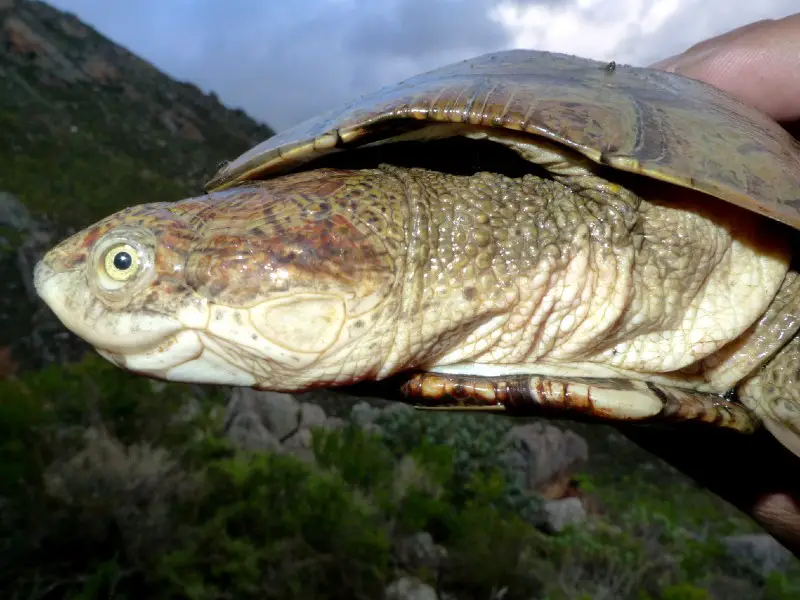
The African sideneck turtle is susceptible to several health issues caused by poor care. The most common health problems include:
- Vitamin A deficiency
- Shell infections
Vitamin A deficiency results from a diet lacking in vitamin A. Lack of vitamin A affects the turtle’s mucus membranes and the epidermis. Symptoms include loss of appetite, swollen eyes with a cloudy appearance, kidney failure, and eye swelling.
Treating vitamin A deficiency in turtles involves oral administration or injections of vitamin A. Dietary changes and vitamin supplements may help avoid future symptoms.
Shell infections result from a turtle spending too much time in dirty water or living in an overcrowded tank. Bacteria, fungi, and parasites enter the turtle’s shell through wounds or weakened spots in the shell. Symptoms of shell infections include lost appetite, difficulty breathing, nasal discharge, swollen legs, and a reddish shell.
Treating turtle shell infections requires antibiotics to kill bacteria, antifungal medications to kill fungi, and antiparasitic drugs to rid the turtle of parasites.
Breeding
A turtle will not breed until it is sexually mature. The male African sideneck turtle is sexually mature at 3–5 years. The female African sideneck turtle will breed when she is 5–7 years old.
Cool African sideneck turtles to a temperature of 60 degrees Fahrenheit for about eight weeks to initiate the breeding process. Feed the turtles food rich in calcium and vitamin D to stimulate egg production.
The ideal breeding ground for African sideneck turtles is a loose, sandy soil area. Lots of males in one area will result in aggressive fighting. Balance the male and female ratio at one male to two females while ensuring a peaceful environment.
The male will initiate the mating process by biting the female’s neck. The mating pair will hold their tails together to form a yin-yang shape as they copulate. The female will deposit between 8–12 eggs into the soil, then cover the eggs up with sand.
Incubating the eggs at a constant temperature between 75–85 degrees Fahrenheit and humidity levels between 30–70% should result in healthy hatchlings. Eggs should hatch after 45 to 60 days.
African sideneck turtle hatchlings are vulnerable to predators in the first year of their life. Hatchlings stay in their shells for several days before emerging. Feed the hatchlings fruits and vegetables, and provide a shallow pool of water until they grow up.
Choosing and Buying an African Sideneck Turtle
African sideneck turtles cost between $50 and $100. The turtles are readily available in pet stores, but you can also find them in online marketplaces. Some reputable breeders will ship healthy turtles.
The US government prohibits trading pet turtles with shells less than four inches long as the turtles carry Salmonella. Watch out for signs of health issues such as cloudy eyes, lethargy, flakiness on the shell, or breathing difficulties. Some African sideneck turtles carry fungus and parasites that can affect other pets.

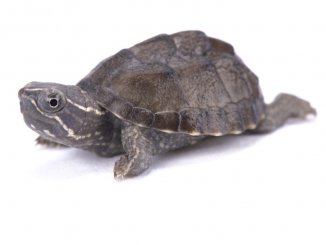
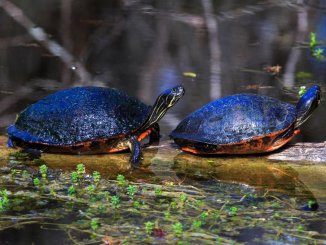
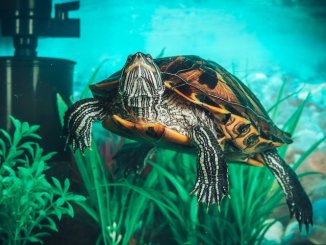

Can I bath or scrub my African side neck female turtles shell with a unused toothbrush and just regular water ??
Your best option would be to use a separate container in which you put lukewarm dechlorinated water (you can use for this purpose a conditioner for freshwater), and a soft unused toothbrush.